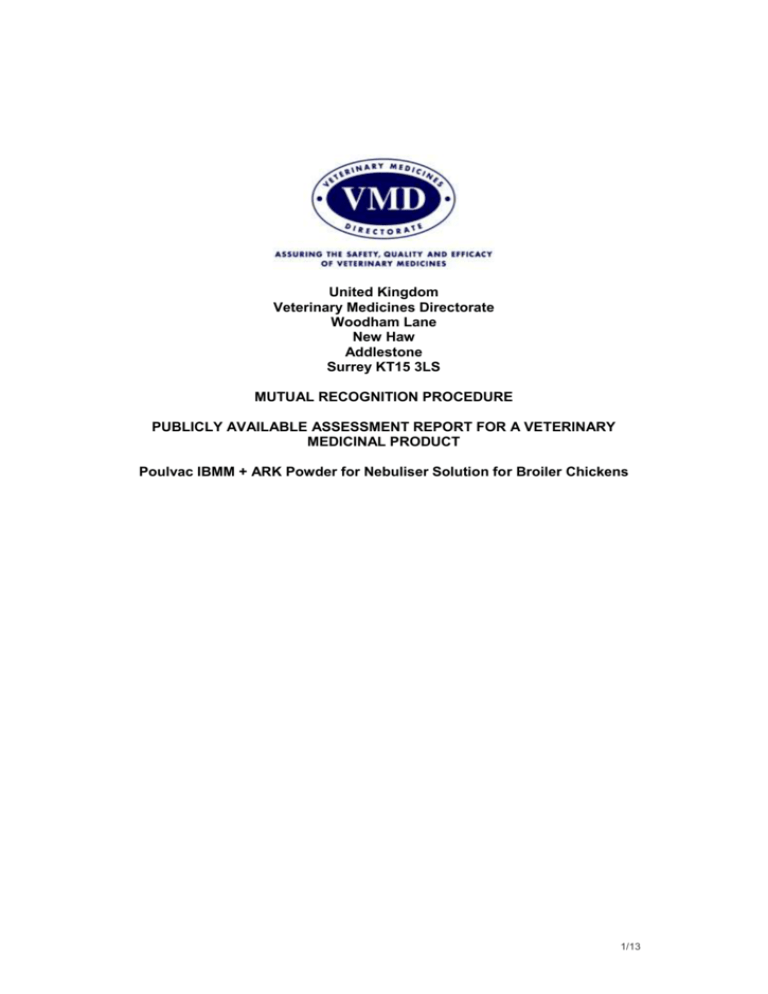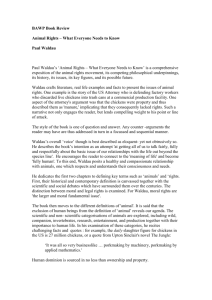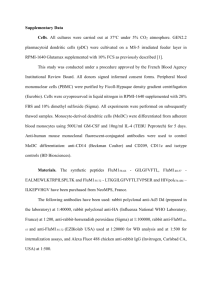United Kingdom Veterinary Medicines Directorate Woodham Lane
advertisement

United Kingdom Veterinary Medicines Directorate Woodham Lane New Haw Addlestone Surrey KT15 3LS MUTUAL RECOGNITION PROCEDURE PUBLICLY AVAILABLE ASSESSMENT REPORT FOR A VETERINARY MEDICINAL PRODUCT Poulvac IBMM + ARK Powder for Nebuliser Solution for Broiler Chickens 1/13 Poulvac IBMM + ARK Powder for Nebuliser Solution for Broiler Chickens UK/V/0180/001/E/001 Pfizer Ltd Application for Mutual Recognition Procedure Publicly Available Assessment Report MODULE 1 PRODUCT SUMMARY EU Procedure number Name, strength and pharmaceutical form UK/V/0180/001/E/001 POULVAC IBMM + ARK – Powder for nebuliser solution for Broiler chickens Applicant Pfizer Ltd, Ramsgate Road, Sandwich, Kent, CT13 9NJ Active substance(s) Avian Infectious Bronchitis Virus (Strain Massachusetts1263 and Strain Arkansas 3168 Global Amount per Dose ≥103.3 EID50* *EID50: Embryo infective dose 50% ATC Vetcode Target species Indication for use QI01AD07 Broiler chickens For the active immunisation of chickens to reduce the severity of upper respiratory tract infections caused by Massachusetts and 793/B/91-type strains of Avian Infectious Bronchitis virus. The onset of immunity is from three weeks post vaccination and lasts for six weeks post vaccination. Protection has also been demonstrated in the presence of maternally derived antibody. VMD/L4/GAT/017/C Last revised October 3rd 2013 2/13 Poulvac IBMM + ARK Powder for Nebuliser Solution for Broiler Chickens UK/V/0180/001/E/001 Pfizer Ltd Application for Mutual Recognition Procedure Publicly Available Assessment Report MODULE 2 The Summary of Product Characteristics (SPC) for this product is available on the Heads of Medicines Agencies (veterinary) (HMA(v)) website (www.hma.eu). VMD/L4/GAT/017/C Last revised October 3rd 2013 3/13 Poulvac IBMM + ARK Powder for Nebuliser Solution for Broiler Chickens UK/V/0180/001/E/001 Pfizer Ltd Application for Mutual Recognition Procedure Publicly Available Assessment Report MODULE 3 PUBLIC ASSESSMENT REPORT Legal basis of original application Application in accordance with Article 13 of Directive 2001/82/EC as amended. (MRP, Repeat Use). Date of completion of the original mutual recognition procedure 05 June 2013 Date product first authorised in the Reference Member State (MRP only) 25 January 2001 Concerned Member States for First Use Austria, Belgium, Czech Republic, original procedure Greece, Ireland, Italy, Luxembourg, Netherlands, Slovakia Repeat Use (First wave) Romania, Bulgaria I. SCIENTIFIC OVERVIEW Poulvac IBMM + ARK Powder for Nebuliser Solution for Broiler Chickens is a live, freeze dried vaccine, designed to be effective against the Massachusetts 1263 and Arkansas 3168-type strains of Avian Infectious Bronchitis virus. It is indicated for active immunisation of chickens to reduce upper respiratory tract infections caused by Avian Infectious Bronchitis virus. The vaccine was originally designed in order to combat the occurrence of a new strain of infectious bronchitis in Europe. The strain 793/B/91 was identified as being immunologically similar to the IBV Arkansas strain, first isolated in the USA. A bivalent vaccine was developed which contained the Arkansas strain with the IB Massachusetts strain. This application was a submitted under the mutual recognition procedure for repeat use. The product was originally authorised under the national procedure in the UK in 2001, and first authorised under the MRP procedure in 2003. The product is delivered as a coarse spray at a dose of 0.5 ml per bird, and the amount per dose is ≥ 10 3.3 EID50.1 The product is produced and controlled using validated methods and tests which ensure the consistency of the product released on the market. It has been shown that the product can be safely used in chickens; the slight reactions observed are indicated in the SPC2. 1 2 EID50 – Embryo infective dose. SPC - Summary of Product Characteristics VMD/L4/GAT/017/C Last revised October 3rd 2013 4/13 Poulvac IBMM + ARK Powder for Nebuliser Solution for Broiler Chickens UK/V/0180/001/E/001 Pfizer Ltd Application for Mutual Recognition Procedure Publicly Available Assessment Report The product is safe for the user, the consumer of foodstuffs from treated animals and for the environment, when used as recommended. Suitable warnings and precautions are indicated in the SPC. The efficacy of the product was demonstrated according to the claims made in the SPC. The overall benefit/risk analysis is in favour of granting a marketing authorisation. II. QUALITY ASPECTS A. Composition The product contains Massachusetts 1263 and Arkansas 3168-type strains of Avian Infectious Bronchitis virus with the excipients pharmatone, bacto-peptone, sucrose, N-Z amine YT, monosodium glutamate and water for injections. The container/closure system consists of 6ml, 10ml and 20ml Type I borosilicate glass closed with 20mm fluted butyl stoppers, sealed with aluminium caps. The particulars of the containers and controls performed are provided and conform to the regulation. The choice of the vaccine strain is justified. The product is an established pharmaceutical form and its development is adequately described in accordance with the relevant European guidelines. B. Method of Preparation of the Product The product is manufactured fully in accordance with the principles of good manufacturing practice from a licensed manufacturing site. Process validation data on the product have been presented in accordance with the relevant European guidelines. C. Eggs aged 9-12 days are inoculated with the virus and incubated for 24 hours at 37˚C. Chorioallantoic fluids from the inoculated eggs are removed. These fluids are stored in sterile 3200 ml – 3500 ml bottles at 2-7˚C for up to 18 hours or frozen at -15˚C for no more than 2 years. The active ingredients and stabiliser are then blended together to make the bulk vaccine and mixed for no less than 10 minutes before filling. Whilst filling, the mixture is stirred continuously, and once full, the vaccine is freeze dried and sealed into vials. Control of Starting Materials The active substances are Massachusetts 1263 and Arkansas 3168-type strains of Avian Infectious Bronchitis virus, established active substances not listed in a Pharmacopoeia. Data is provided showing testing carried out to European Pharmacopoeial (Ph. Eur.) standards. The active substance is manufactured in accordance with the principles of good manufacturing practice. VMD/L4/GAT/017/C Last revised October 3rd 2013 5/13 Poulvac IBMM + ARK Powder for Nebuliser Solution for Broiler Chickens UK/V/0180/001/E/001 Pfizer Ltd Application for Mutual Recognition Procedure Publicly Available Assessment Report Starting materials of non-biological origin used in production comply with pharmacopoeial monographs (gentamicin sulphate, water for injections and sucrose) or in-house specifications (tryptose phosphate broth, bacto-peptone, pharmatone and N-Z amine YT). Biological starting materials used are in compliance with the relevant Ph. Eur. monographs and guidelines and are appropriately screened for the absence of extraneous agents according to the Ph. Eur. The master and working seeds have been produced according to the Seed Lot System as described in the relevant guideline. D. Specific Measures concerning the Prevention of the Transmission of Animal Spongiform Encephalopathies Scientific data demonstrating compliance with the Note for Guidance on Minimising the Risk of Transmitting Animal Spongiform Encephalopathy Agents via Human and Veterinary Medicinal Products has been provided. E. Control tests during production The tests performed during production are described and the results of 3 consecutive runs, conforming to the specifications, are provided. Tests are performed on inoculated eggs and viral fluids, in order to determine viability and specificity respectively. F. Control Tests on the Finished Product Tests on the final product include visual inspections of a random selection of vials, identity (serum neutralisation assay), safety, sterility, purity, and detection of relevant extraneous agents. The tests performed on the final product conform to the relevant Ph. Eur. requirements. The demonstration of the batch to batch consistency is based on the results of 3 batches produced according to the method described in the dossier. Other supportive data provided confirm the consistency of the production process. G. Stability Stability data on the active substances have been provided in accordance with applicable European guidelines, demonstrating the stability of the active substance when stored under the approved conditions. The active substance is fully tested to ensure compliance with its specification immediately prior to its use in manufacture of the product. Stability data on the finished product have been provided in accordance with applicable European guidelines, demonstrating the stability of the product throughout its shelf life when stored under the approved conditions. The in-use shelf-life (2 hours) of the reconstituted vaccine is supported by the data provided. H. Genetically Modified Organisms Not Applicable VMD/L4/GAT/017/C Last revised October 3rd 2013 6/13 Poulvac IBMM + ARK Powder for Nebuliser Solution for Broiler Chickens UK/V/0180/001/E/001 Pfizer Ltd Application for Mutual Recognition Procedure Publicly Available Assessment Report J. Other Information Shelf-life: 2 years for the freeze dried vaccine Shelf-life after reconstitution according to directions: 2 hours Store and transport refrigerated (2 ºC – 8 ºC). Protect from light. Do not freeze. III. SAFETY ASSESSMENT Laboratory trials The safety of the administration of one dose, an overdose and the repeated administration of one dose of the product in the target animal was demonstrated in chickens, in GLP3-compliant studies. In one study, for a single and repeated dose, a group of 30 chickens were given 10 6.8 EID50 of the vaccine per chicken in order to guarantee a dose of 10 5.78 EID50 (the maximum release titre). The birds were sprayed with the vaccine and then isolated and observed for 21 days. At 21 days post vaccination the birds were again vaccinated at maximum titre and observed for a further 21 days. No mortality or adverse reactions occurred. The investigation was performed according to the recommendations of Directive 2001/82/EC as amended and the relevant guidelines. Other supportive studies were performed on the safety of a single dose of the individual vaccine components. No adverse effects were seen. A further supportive study was provided which analysed the immunological function of IBMM + ARK on Newcastle disease virus strains, herpes virus turkey, bursal disease and tenosynovitis virus. This study, which included a negative control group, was intended to detect any interference to the product from the other vaccine strains, when all were given simultaneously as a coarse spray. The efficacy of the IBMM + ARK vaccine was maintained, with vaccinated birds showing a 90% challenge protection when compared to negative controls. A further study investigated overdose of the product. Young chickens were inoculated with x 10 or x 20 the recommended dose of the bronchitis vaccine, results confirmed that the product was safe if given at overdose at these amounts. Effects on reproductive performance were examined. The results indicated that the Massachusetts 1263 strain is sufficiently attenuated so as not to induce cysts in the oviduct of birds vaccinated at one day of age. However, the safety of the ARK vaccine strain has not been evaluated, and therefore a contraindication on the SPC regarding the use in birds intended for laying or breeding, or during the laying period has been included. 3 GLP – Good Laboratory Practise. VMD/L4/GAT/017/C Last revised October 3rd 2013 7/13 Poulvac IBMM + ARK Powder for Nebuliser Solution for Broiler Chickens UK/V/0180/001/E/001 Pfizer Ltd Application for Mutual Recognition Procedure Publicly Available Assessment Report Spread of IBMM and ARK vaccine strains For the IBMM component, groups of 15 chickens received a dose of either 10 1.9, 10 2.8 or 10 3.7 EID50 via eye drop. Immediately after vaccination, 10 nonvaccinated controls were put into direct contact with the vaccinated birds. Challenge infection three weeks post-vaccination via eye-drop (10 5.1 EID50) showed both vaccinated and control birds as protected (virus recovery test 5 days post challenge). Therefore, it was concluded that the vaccine strain spreads to non-vaccinated animals, and an appropriate warning and recommendation to vaccinate all birds on site has been included on the SPC. A similar study was carried out for the ARK component. Chickens were divided into 2 groups of 40 and one of 25, and inoculated with the ARK strain. The birds received a dose of 10 5.5 EID50 per bird. Post-inoculation, a sample of the vaccinated chickens were tested for immune status, and negative control birds placed with inoculated birds. After samples were taken over a period of days, the birds were sacrificed and further samples taken and analysed. Traces of virus were found in the control birds, and therefore the SPC carries a warning with regard to spread of the vaccine. Dissemination of IBMM and ARK IBMM The dissemination study was conducted in day old chickens vaccinated by eye drop with 10 5.2 EID50 IBMM strain. Dissemination was limited to the tracheal and intestinal tissue, and could be isolated up to 23 days post-vaccination. It was not possible to isolate the virus from the kidneys at any time point in the study. From this study it was concluded that the virus is cleared from the bird within 23 days. ARK 75 chickens were divided into 2 groups of 40 and 25 individuals. (This was the same study that was used to investigate the spread of the virus). The birds were inoculated with X+4 working seed virus of the Arkansas strain. Control birds were put into contact with vaccinated birds 3 days post inoculation for the remainder of the study. In the vaccinated birds, virus was detected in the trachea 3 days post vaccination, and in decreasing concentrations at 7 and 10 days. By 14 days the virus was no longer detectable. On day 7 and day 28 postvaccination a small amount of the virus was detected in the kidneys, and virus was found in faeces at day 14. In the control birds, low levels of virus were found at 17 days post vaccination. From this, it was concluded that the ARK strain spreads and has a predilection for the trachea, but may also be found in the kidneys and faeces. Appropriate warnings are included on the SPC. Reversion of virulence of attenuated vaccines IBMM A serial passage study was performed with IBMM working seed virus at a titre of 10 4.8 EID50, (equivalent to 10 3.3 EID50/dose). After the 5th passage in susceptible birds, the supernatant from the 5th isolate and the original X+1 isolate was inoculated into 9 eggs to determine whether reversion to virulence had occurred. VMD/L4/GAT/017/C Last revised October 3rd 2013 8/13 Poulvac IBMM + ARK Powder for Nebuliser Solution for Broiler Chickens UK/V/0180/001/E/001 Pfizer Ltd Application for Mutual Recognition Procedure Publicly Available Assessment Report No positive IB infection was detected in lesions. It was concluded from this that the strain is stable and does not revert to virulence when serially passaged. ARK A suitable number of birds were inoculated with the Arkansas vaccine strain, and 56 days later a second round of inoculations took place in another group of birds, using the same vaccine. For the initiation of serial passage, a group of 10 chickens was inoculated with 10 6.0 EID50/0/06 ml. For subsequent passages the vaccine was delivered undiluted. Post-euthanasia, tracheal material from the birds was used to detect viral load, and used for further inoculations. It was seen from the ensuing results that the Arkansas strain did not revert to virulence. Field studies In the key trial, 2 groups of a suitable number of broiler chickens were either vaccinated with IBMM + ARK and additional vaccines, or the additional vaccines alone. A further control group, given the additional vaccines, was housed in a separate location, in order to observe possible vaccine shedding. At one day of age, groups 1 and 2 were given one of the additional vaccines via spray, and group 1 were given IBMM + ARK vaccine. At 15 days of age, chickens in groups 1 and 2 were given the second additional vaccine via drinking water. At 4 weeks of age, all chickens were re-vaccinated with the first additional vaccine. Chickens were observed daily throughout the study for clinical signs, no respiratory symptoms were noted during the trial. Serology showed that the virus had spread from group 1 to group 2, 5 weeks into the trial. In a supporting trial, the strains were administered through drinking water to birds aged 8-22 days. Vaccinated birds were observed for 2 weeks post vaccination and no adverse reactions or mortality was observed. From these studies, it was determined that vaccination using these strains by coarse spray is safe. Supporting studies on a trivalent vaccine and testing at a commercial level site confirmed the safety of the product. Ecotoxicity The applicant provided a first phase environmental risk assessment in compliance with the relevant guideline which showed that no further assessment was required. Warnings and precautions as listed on the product literature are adequate to ensure safety to the environment when the product is used as directed. VMD/L4/GAT/017/C Last revised October 3rd 2013 9/13 Poulvac IBMM + ARK Powder for Nebuliser Solution for Broiler Chickens UK/V/0180/001/E/001 Pfizer Ltd Application for Mutual Recognition Procedure Publicly Available Assessment Report IV CLINICAL ASSESSMENT (EFFICACY) As this vaccine was produced due to the appearance of a new IB strains in Europe, the applicant used two existing monovalent vaccines to produce the new product. Clinical Studies Laboratory Trials The efficacy of the product was demonstrated in two key laboratory studies in accordance with the relevant requirements:In the first study, a group of 50 chickens were vaccinated with the combined vaccine via spray application. A control group of 40 chickens were left unvaccinated. At 3 weeks of age, 20 randomly selected vaccinated chickens and 10 randomly selected control chickens were challenged with 10 3 EID50 virulent M41 virus. The same numbers of chickens from each group were also challenged with10 5 EID50 virulent IB 793/91 virus. Challenge was given via a nosedrop at 0.5ml/chick. Cilia stopping tests were used to determine protection, with cilia stopping or impaired movement indicative of lack of protection. Protection against IBM41 was 80% in test group and 0% in the control group. Against IB, 793/91 protection was 100% in test group and 60% in control group. This study confirmed the efficacy of the product at 21 days post-vaccination. A second study established the efficacy of the combined vaccine against strain 793/B/91. Forty chickens were vaccinated via spray with 10 3.2 of IB Mass and 10 4.58 of ARK. The final product was given at a dose of 10 5.5 EID50. Four weeks after vaccination, a sample of vaccinated and unvaccinated animals were challenged intranasally, and examined post mortem after a suitable interval. The virus was found to have had a severe effect on the upper-tracheal cilia of unvaccinated animals, whereas as vaccinated chickens were protected. In a third second study, 100 commercial broilers were vaccinated via spray application with 10 3 EID50 IBMM and 10 3 EID50 Ark. 60 chickens were used as an unvaccinated control group and were housed separately. At 3 weeks of age, 24 vaccinated and 15 control chickens were challenged with IB M41 virus, and 24 vaccinated and 15 control chickens were challenged with IB 793B/91 virus. The challenge was administered by nosedrop. The challenge procedure was repeated at 6 weeks of age using 16 vaccinated and 10 control chickens. Protection, assessed by mean antibody titres, at 3 weeks against IB M41 was 93% for vaccinated chickens and 3% for control chickens. Protection against IB 793B/91 was 96% for vaccinated chickens and 77% for controls. At 6 weeks, protection against IB M41 was 77% for vaccinates and 5% for controls, and protection against IB 793B/91 was 77% for vaccinates and 20% for controls. A further supporting study examined the minimum protective dose for the IBMM component. Groups of 20 chickens were given three doses of vaccine occularly or via spray and drinking water. The birds were challenged three weeks later and it was noted from results that a protection of 10 1.8 EID50 was provided when the product was given by eye drop. Another supporting study which also analysed minimum protective dose, but using the ARK component only. The results were supportive of a minimum protective dose of 10 2.1 EID50. Other supporting VMD/L4/GAT/017/C Last revised October 3rd 2013 10/13 Poulvac IBMM + ARK Powder for Nebuliser Solution for Broiler Chickens UK/V/0180/001/E/001 Pfizer Ltd Application for Mutual Recognition Procedure Publicly Available Assessment Report studies on the individual vaccine components were also submitted, in addition to a trial aimed at determining maternal antibody interference. An additional study analysed the use of a Salsbury coarse spray activator and after vaccination with doses of between 10 1.5 EID50 and 10 2.5 EID50 with subsequent challenge with virus at 10 4.0 EID50, the minimum protected dose was found to be 10 2.5 EID50/0/07 ml. Field Trials Study title Objectives Test site(s) Compliance with Regulatory guidelines Test Product Control product/placebo Animals Outcomes/endpoints Randomisation Blinding Method Statistical method RESULTS VMD/L4/GAT/017/C Last revised October 3rd 2013 Efficacy and compatibility in commercial broilers after coarse spray application under field conditions. To determine the duration of immunity for the vaccine under field conditions in a commercial setting. Single centre, undisclosed location Good Clinical Practice (GCP) Poulvac IBMM + ARK vaccine Negative control (no treatment) 14,042 commercial broilers were used in total.10 one day old chickens used for taking blood. 100 chickens were taken as unvaccinated control birds. The remainder were split into two groups. Inclusion/exclusion criteria not given. Instead, justifications for mortality not attributed to the vaccine has been included. % Protection (measured by cilia stopping method at 3 and 6 weeks) Randomised, but randomisation method not disclosed. unblinded The chickens were housed on wood shavings. One of the two test groups was vaccinated at one day of age with the test product and additional vaccines and the other group with only the additional vaccines. The chickens were confined to boxes for 3 hours post vaccination. At 3 weeks of age 25 chickens from group 1 and 15 chickens from group 3 (totally unvaccinated chickens) were challenged with 103 EID50 virulent IBM41 virus, and 25 chickens from group 1 and 15 chickens from group 3 were challenged with 105 EID50 virulent 793B/91 virus. This was repeated at 6 weeks of age. Protection against challenge was determined by the cilia stopping method. Six days post challenge all remaining challenged and non-challenged birds were euthanized. Cilia stopping method – 6 days post challenge all remaining selected birds are euthanized and the trachea of each bird was analysed by microscopy to assess cilia activity. Protection is conferred when the cilia are still able to move freely. The data was sufficient to support a claim for onset of immunity from 3 weeks post-vaccination, and duration 11/13 Poulvac IBMM + ARK Powder for Nebuliser Solution for Broiler Chickens UK/V/0180/001/E/001 Pfizer Ltd Application for Mutual Recognition Procedure Publicly Available Assessment Report Duration of follow-up Outcomes for endpoints of immunity of 6 weeks. None % protection against IMB41 (3 weeks): Vaccinated – 77 Control – 0 % protection against IMB41 (6 weeks): Vaccinated – 96 Control - 63 % protection against 793B/91 (3 weeks): Vaccinated – 92 Control - 3 % protection against 793B/91 (6 weeks): Vaccinated – 90 Control - 7 Adverse events DISCUSSION ‘normal’ mortality rate quoted as advised by the Animal Health Service of the Netherlands – 4.6% This study demonstrated activity against Massachusetts and B7930-like strains of Avian Infectious Bronchitis virus. V OVERALL CONCLUSION AND BENEFIT– RISK ASSESSMENT The data submitted in the dossier demonstrate that when the product is used in accordance with the Summary of Product Characteristics, the benefit/risk profile for the target species is favourable and the quality and safety of the product for humans and the environment is acceptable. VMD/L4/GAT/017/C Last revised October 3rd 2013 12/13 Poulvac IBMM + ARK Powder for Nebuliser Solution for Broiler Chickens UK/V/0180/001/E/001 Pfizer Ltd Application for Mutual Recognition Procedure Publicly Available Assessment Report MODULE 4 POST-AUTHORISATION ASSESSMENTS The SPC and package leaflet may be updated to include new information on the quality, safety and efficacy of the veterinary medicinal product. The current SPC is available on the Product Information Database of the Veterinary Medicines Directorate website. (www.gov.uk/check-animal-medicine-licensed) The post-authorisation assessment (PAA) contains information on significant changes which have been made after the original procedure which are important for the quality, safety or efficacy of the product. The PAA for this product is available on the Product Information Database of the Veterinary Medicines Directorate website. (www.gov.uk/check-animal-medicine-licensed) VMD/L4/GAT/017/C Last revised October 3rd 2013 13/13


![Newsletter 26.04.13[1]](http://s3.studylib.net/store/data/006782410_1-da9f3895022a2272f47db633b66536f9-300x300.png)


